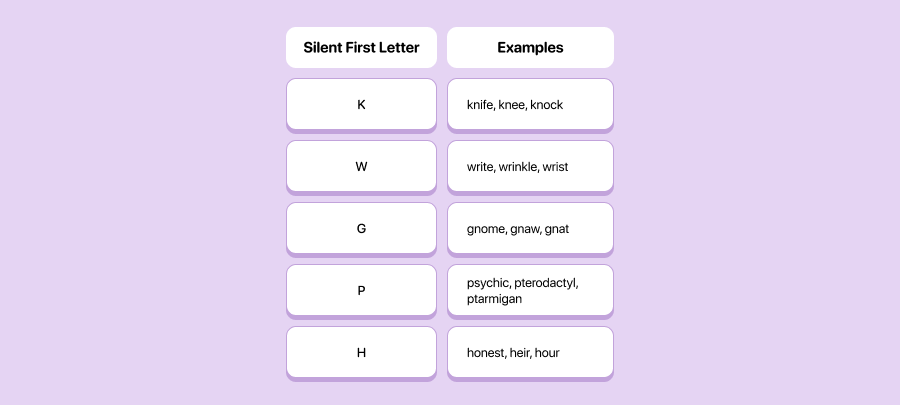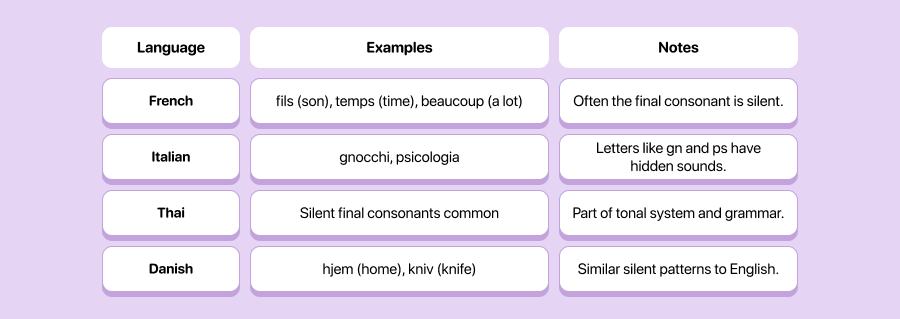Silent letters are the ghosts of language. You don’t hear them, but they’re there, shaping meaning, history, and pronunciation. Let’s explore the mystery of silent letters: how they work, why they exist, and which ones give language learners the most trouble.
What Are Silent Letters?
A silent letter is a letter in a word that is written but not pronounced. It’s there on paper but disappears in speech.
Think of the "k" in "knife", the "b" in "thumb", or the "w" in "write." These are not typos or mistakes; they're fossilized parts of older pronunciations that languages have moved past, but spelling hasn’t.
Why Do Silent Letters Exist?
There’s no single reason, but here are the most common:
1. Historical pronunciation shifts
Languages evolve. English used to pronounce the "k" in “knight” (like /k-neecht/), but not anymore. Spelling stayed the same, though.
2. Borrowed words
English steals, uh, borrows a lot of words. It adopted "champagne" from French, "tsunami" from Japanese, and more. Many of these keep their silent or awkward spellings.
3. Visual cues for meaning
The "b" in "doubt" is silent, but it reminds us of its Latin cousin “dubitum.” That keeps it visually connected to other words like “dubious.”
4. French influence
Wondering why does French have so many silent letters? Blame history and elegance. Old French phonetics kept certain endings silent (like “eaux” in châteaux), but their spellings stuck around to mark gender, tense, or plural forms. English absorbed much of this when the Normans invaded in 1066, introducing French vocabulary and spelling, including the use of silent letters.
Words With Silent Letters (and What to Watch For)
Let’s get practical. Here are some classic categories and examples of English words with silent letters that trip people up.
Words with silent first letters
Words with silent letters at the beginning are especially tricky, since they make you start a word wrong if you don't know better.

These are some of the most popular words that start with silent letters, and they’re surprisingly common!
Difficult words with silent letters
English is full of hard-to-pronounce words for learners, especially those where silent consonants show up unexpectedly.

Why English Loves Silent Consonants
The real answer? A mix of linguistic chaos, foreign invasions, and bad timing. English went through a phase where pronunciation changed rapidly (called the Great Vowel Shift), but spelling rules stayed mostly frozen in time.
Plus, thanks to French, Latin, Greek, Norse, and other influences, English became a salad of spelling systems. That’s why you get words like:
- Colonel (pronounced "kernel")
- Ballet (say it the French way)
- Debris (don’t pronounce that final “s”)
So if you’re wondering why silent letters in English feel so random, it’s because they kind of are!
How to Learn Words With Silent Letters (Without Crying)
Here are a few learner-friendly tips:
✅ 1. Group them
Learn words with silent letters in chunks. For example:
- K + N words: knife, knight, knock
- G + N words: gnome, gnat, gnaw
📖 2. Use mnemonics
To remember "mnemonic" starts with a silent m, say: “Memory Needs Every Method Of Noting Important Clues.”
🔁 3. Practice aloud
Reading silently won’t help. You need to hear the words and say them to remember which letters disappear in pronunciation.
📱 4. Use apps with audio
Language tools like EWA show you the word, pronounce it clearly, and use it in a sentence. Perfect for silent consonants that confuse learners!
Not Just English: Silent Letters in Other Languages
Silent letters are not exclusive to English. Here’s how they show up in other languages:

Silent letters might feel like a cruel joke when you’re trying to spell or pronounce a word right. But they’re also a beautiful reminder of how language evolves: full of stories, history, and quirks.
Mastering silent letters in English takes practice, but it’s 100% doable. Focus on common patterns, listen carefully, and don’t be afraid to say a word wrong. Even native speakers mess these up!
FAQ
1. Why does English have so many silent letters compared to other languages?
English has more silent letters because it evolved from many different languages: Old English, Norse, Latin, French, and Greek, all with their own spelling systems. When pronunciation changed over time (especially during the Great Vowel Shift), spellings often stayed the same.
That’s why modern English words like knight, debt, and receipt still include silent letters that reflect their historical roots.
2. How can I tell which letters are silent in a word?
There’s no universal rule, but common patterns help. For example:
- kn, gn, ps, wr = silent first letter (knee, gnome, psychology, wrist);
- mb at the end = silent b (thumb);
- Silent l in words like salmon and calm.
The best way to learn is through repeated exposure: listen to native speakers, read aloud, and study groups of similar words.
3. Are there any tricks for learning difficult words with silent letters?
Yes! There are several techniques that help:
- Use mnemonics: Mnemonics are memory aids, simple phrases or mental images that help you remember tricky spellings. For example, to remember the silent “k” in knight, you might say, "A knight is silent at night." These tricks make the spelling more memorable by connecting it to a story or idea.
- Group similar words: Study words with the same silent letter patterns together (like thumb, comb, limb for silent “b”). Seeing the pattern makes it easier to remember and recognize it in new words.
- Listen to native pronunciation: Use apps, YouTube videos, or online dictionaries with audio to hear how words are actually pronounced. This helps train your ear and makes silent letters stand out.
- Practice out loud: Speaking the words, even just whispering them, helps your brain and mouth learn the rhythm of natural English pronunciation, even if some letters aren’t spoken.
- Write and repeat: Rewriting difficult words a few times while focusing on the silent letters builds muscle memory and spelling awareness.
- Flashcards and quizzes: These are great for testing yourself and building quick recall. Include both the spelling and audio if possible.


















